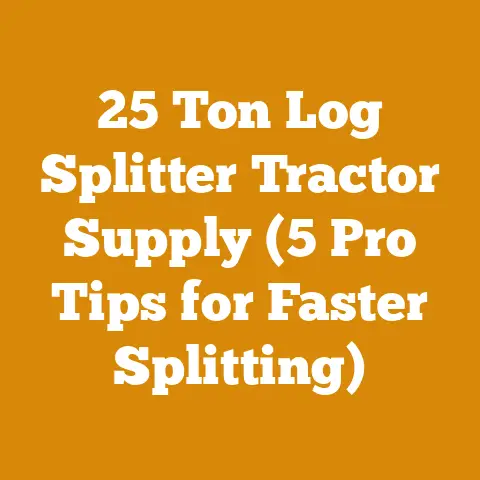Winch Pulling Tree Techniques (5 Pro Tips for Safe Felling)
Have you ever felt the adrenaline rush of felling a tree, only to watch it land in the wrong spot, creating a potential hazard or hindering your progress?
I have.
More times than I care to admit.
That’s why I’m so passionate about sharing the power of winch pulling techniques.
Using a winch properly isn’t just about brute force; it’s about control, precision, and, most importantly, safety.
Mastering these techniques can be the difference between a successful felling operation and a costly, even dangerous, mistake.
In this guide, I’m going to share five pro tips that will transform your approach to winch pulling trees, whether you’re a seasoned logger or a weekend warrior clearing your property.
I’ll draw on my years of experience, share some hard-earned lessons, and provide practical insights to help you fell trees safely and predictably.
Let’s get started.
Why Winch Pulling Is Essential for Safe Tree Felling
Before diving into the techniques, let’s understand why winch pulling is such a critical skill.
In many situations, simply making the cuts and hoping for the best isn’t enough.
Trees can lean in unpredictable directions, be affected by wind, or be entangled with other trees.
Winch pulling provides the directional control needed to ensure the tree falls where you want it to, minimizing risks and maximizing efficiency.
Think about it: how many times have you seen a tree hang up in another, creating a dangerous “widowmaker” situation?
Or perhaps a tree fell across a fence, requiring extra work to clear?
These are the kinds of problems winch pulling can prevent.
Understanding the Forces Involved
Winch pulling applies a controlled force that overcomes the tree’s natural lean or resistance.
It’s crucial to understand the forces at play:
- Gravity: The primary force we’re working with.
- Tree’s Lean: The natural direction the tree wants to fall.
- Winch Pull: The force we apply to influence the direction of the fall.
- Resistance: This can include branches, other trees, or the tree’s own internal stresses.
By understanding these forces, we can strategically position the winch and apply the appropriate amount of tension to achieve the desired result.
Tip #1: Choosing the Right Winch and Equipment
The foundation of safe and effective winch pulling lies in selecting the right equipment.
Don’t skimp on quality here; your safety and the success of your project depend on it.
Winch Capacity:
The first consideration is winch capacity.
A good rule of thumb is to choose a winch with a pulling capacity at least 1.5 to 2 times the estimated weight of the tree.
Estimating tree weight can be tricky, but you can use formulas based on tree diameter and species.
- Example: For a tree with a diameter of 20 inches and a height of 60 feet, you might estimate its weight to be around 3,000 lbs (depending on the wood species).
In this case, you’d want a winch with a capacity of at least 4,500 to 6,000 lbs.
Winch Types:
There are several types of winches available:
- Manual Winches: These are suitable for smaller trees and lighter pulling tasks.
They’re affordable but require significant physical effort. - Electric Winches: Powered by a battery, these offer more pulling power than manual winches and are easier to operate.
They’re a good choice for occasional use. - Hydraulic Winches: The most powerful and reliable option, hydraulic winches are ideal for heavy-duty logging operations.
They require a hydraulic power source (e.g., a tractor or skidder).
Essential Accessories:
- Winch Rope or Cable: Choose a high-quality rope or cable with a sufficient breaking strength.
Synthetic ropes are lighter and safer than steel cables, but they can be more expensive. - Snatch Block (Pulley): This doubles the pulling power of your winch and allows you to change the direction of the pull.
- Tree Saver Strap: Protects the tree you’re anchoring to from damage.
- Shackles: Connect the winch rope, snatch block, and tree saver strap.
- Chainsaw: Obvious, but essential for making the necessary cuts.
- Wedges: Help direct the fall of the tree.
- Personal Protective Equipment (PPE): Helmet, eye protection, hearing protection, gloves, and chainsaw chaps are non-negotiable.
My Experience:
I once tried to save a few bucks by using a cheap winch cable.
During a pull, the cable snapped, sending the broken end whizzing through the air.
Luckily, no one was hurt, but it was a close call.
From that day on, I’ve always invested in high-quality equipment, no matter the cost.
It’s a lesson I learned the hard way.
Data Point: According to the Occupational Safety and Health Administration (OSHA), using the wrong equipment or improperly maintained equipment is a leading cause of logging accidents.
Tip #2: Mastering the Art of Anchor Selection
The anchor point is just as important as the winch itself.
A weak or poorly chosen anchor can lead to equipment failure and potentially dangerous situations.
Ideal Anchor Points:
- Large, Healthy Trees: Choose trees with a diameter of at least 12 inches and no signs of decay or disease.
- Stumps: Solid, well-rooted stumps can also serve as reliable anchor points.
- Heavy Equipment: Tractors, skidders, or other heavy machinery can be used as anchors, provided they are properly positioned and secured.
Avoiding Unsuitable Anchors:
- Small Trees: These may not be strong enough to withstand the pulling force.
- Dead or Decaying Trees: These are prone to snapping or uprooting.
- Rocks or Boulders: These can shift or roll under pressure.
Anchor Placement:
The angle of the pull relative to the anchor point is crucial.
Ideally, the winch line should be as close to a straight line as possible between the winch and the tree being felled.
This minimizes stress on the anchor and maximizes pulling efficiency.
- Example: If you want the tree to fall to the east, position the anchor point to the east of the tree.
Using a Snatch Block for Anchor Flexibility:
A snatch block allows you to change the direction of the pull without moving the anchor point.
This is especially useful when you’re working in tight spaces or when the ideal anchor point is not directly in line with the desired felling direction.
My Insight:
I often use a snatch block to redirect the winch line around obstacles or to create a more favorable pulling angle.
It’s a simple tool that can significantly improve your control and efficiency.
Case Study:
I was once felling trees in a densely wooded area with limited space for maneuvering.
The only suitable anchor point was a large oak tree located at a 45-degree angle to the desired felling direction.
By using a snatch block, I was able to redirect the winch line and pull the tree in the correct direction without having to reposition the anchor.
Tip #3: Precise Cutting Techniques for Winch-Assisted Felling
The cuts you make on the tree are just as important as the winch pulling itself.
Precise cutting techniques, combined with strategic winch placement, will ensure the tree falls exactly where you want it to.
The Hinge:
The hinge is the most critical element of directional felling.
It’s the strip of wood that connects the stump to the falling tree and controls the direction of the fall.
- Hinge Width: The width of the hinge should be approximately 80% of the tree’s diameter.
- Hinge Depth: The depth of the hinge should be consistent and uniform.
- Hinge Alignment: The hinge should be aligned with the desired felling direction.
The Notch:
The notch determines the initial direction of the fall.
There are several types of notches:
- Open-Faced Notch: This is the most common type of notch and provides a wide opening for the tree to fall into.
- Humboldt Notch: This notch is used for larger trees and provides more control over the fall.
- Conventional Notch: This notch is suitable for smaller trees and simpler felling operations.
The Back Cut:
The back cut severs the remaining wood fibers and allows the tree to fall.
It should be made slightly above the bottom of the notch, leaving the hinge intact.
Wedge Placement:
Wedges can be used to help lift the tree and direct its fall.
They are especially useful when the tree is leaning in the wrong direction or when it’s entangled with other trees.
- Example: If the tree is leaning slightly to the left, place a wedge on the right side of the back cut to help push the tree to the right.
Integrating Winch Pulling with Cutting:
Start applying tension with the winch before completing the back cut.
This will help guide the tree in the desired direction as it falls.
As you make the back cut, monitor the hinge and adjust the winch tension as needed to maintain control.
Data Point: Studies have shown that using proper cutting techniques can reduce the risk of tree felling accidents by up to 50%.
Tip #4: Mastering Winch Pulling Techniques: Gradual Tension and Constant Monitoring
Winch pulling isn’t about yanking a tree down; it’s about applying gradual, controlled tension and constantly monitoring the situation.
This approach minimizes the risk of sudden movements or equipment failure.
Gradual Tension:
Start with a small amount of tension and gradually increase it as needed.
Avoid sudden jerks or excessive force, which can overload the winch and cause the rope or cable to snap.
Constant Monitoring:
Continuously monitor the tree, the winch, and the anchor point for any signs of stress or instability.
Look for:
- Cracking or Splitting: In the tree being felled or the anchor tree.
- Movement: Of the anchor point or the winch itself.
- Strain: On the winch rope or cable.
Communication:
If you’re working with a team, establish clear communication signals.
Use hand signals or radios to coordinate your actions and ensure everyone is aware of the situation.
Adjusting Tension:
As the tree begins to fall, you may need to adjust the winch tension to maintain control.
If the tree is falling too quickly, release some tension.
If it’s falling too slowly, increase the tension.
Dealing with Hang-Ups:
Sometimes, despite your best efforts, a tree may hang up in another tree.
In this situation, stop immediately and assess the situation.
Do not attempt to dislodge the tree by force.
Instead, consider:
- Using a Tree Climbing Harness: To safely climb the tree and cut the branches that are causing the hang-up.
- Using a Second Winch: To pull the tree in a different direction.
- Calling a Professional: If you’re not comfortable dealing with the situation yourself.
My Story:
I once had a tree hang up in a massive oak.
I was tempted to just keep pulling with the winch, but I knew that could be incredibly dangerous.
Instead, I called a certified arborist who was able to safely climb the oak and remove the branches that were causing the hang-up.
It cost me a bit of money, but it was well worth it to avoid a potentially life-threatening situation.
Tip #5: Safety First: Prioritizing Your Well-being and Preventing Accidents
Safety is paramount in all aspects of tree felling, especially when using a winch.
Never compromise on safety, and always follow these guidelines:
Personal Protective Equipment (PPE):
Always wear the appropriate PPE:
- Helmet: Protects your head from falling branches or debris.
- Eye Protection: Prevents wood chips and dust from entering your eyes.
- Hearing Protection: Reduces the risk of hearing damage from chainsaw noise.
- Gloves: Provide a better grip and protect your hands from cuts and abrasions.
- Chainsaw Chaps: Protect your legs from chainsaw cuts.
- Steel-Toed Boots: Protect your feet from falling objects.
Establish a Safe Zone:
Clear a wide area around the tree being felled and the anchor point.
Keep all bystanders at a safe distance.
The safe zone should be at least twice the height of the tree.
Inspect Your Equipment:
Before each use, thoroughly inspect your winch, rope, cable, shackles, and other equipment for any signs of damage or wear.
Replace any damaged equipment immediately.
Be Aware of Your Surroundings:
Pay attention to the terrain, weather conditions, and any potential hazards in the area.
Be especially cautious in windy conditions, which can make tree felling unpredictable.
Plan Your Escape Route:
Before making any cuts, identify a clear escape route in case the tree falls in an unexpected direction.
Never Work Alone:
Always work with a partner or team.
This ensures that someone is there to help in case of an emergency.
Training and Certification:
Consider taking a tree felling course or obtaining certification in safe logging practices.
This will provide you with the knowledge and skills you need to fell trees safely and efficiently.
Key Safety Considerations
- Snapback Zone: Be aware of the potential snapback zone if a winch cable or rope breaks.
Stay out of this area. - Overloading: Never exceed the rated capacity of your winch or other equipment.
- Fatigue: Take frequent breaks to avoid fatigue, which can impair your judgment and increase the risk of accidents.
- Alcohol and Drugs: Never operate a chainsaw or winch under the influence of alcohol or drugs.
My Biggest Regret:
I once witnessed a logging accident where a worker was seriously injured because he wasn’t wearing his helmet.
It was a preventable tragedy, and it reinforced the importance of always prioritizing safety.
Data Point: According to the National Institute for Occupational Safety and Health (NIOSH), logging is one of the most dangerous occupations in the United States, with a fatality rate that is significantly higher than the national average.
Conclusion: Mastering Winch Pulling for Safe and Efficient Tree Felling
Winch pulling is a valuable skill that can significantly improve the safety and efficiency of your tree felling operations.
By following these five pro tips – choosing the right equipment, selecting a solid anchor, using precise cutting techniques, applying gradual tension, and prioritizing safety – you can fell trees with confidence and control.
Remember, tree felling is a complex and potentially dangerous activity.
Always prioritize safety, use the right equipment, and never hesitate to seek professional help when needed.
With practice and patience, you can master the art of winch pulling and become a safer, more efficient, and more confident tree feller.
I hope my experience and insights help you on your journey.
Stay safe out there!






